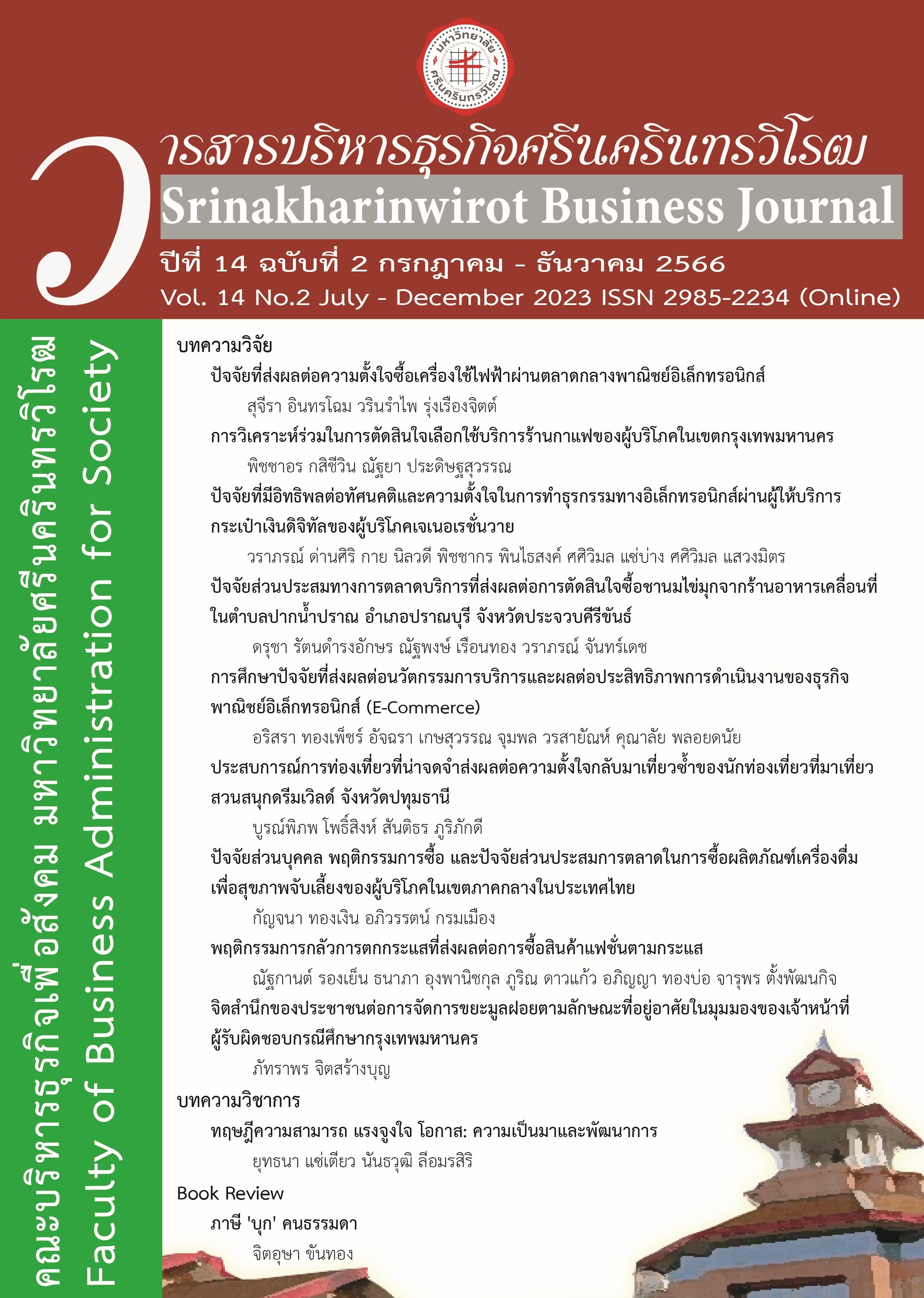FACTORS INFLUENCING ATTITUDE AND INTENTION TO MAKE ELECTRONIC PAYMENTS VIA DIGITAL WALLET PROVIDERS OF GENERATION Y CONSUMERS
ปัจจัยที่มีอิทธิพลต่อทัศนคติและความตั้งใจในการทำธุรกรรม ทางอิเล็กทรอนิกส์ผ่านผู้ให้บริการกระเป๋าเงินดิจิทัล ของผู้บริโภคเจเนอเรชั่นวาย
Keywords:
Digital wallet, Attitude, Behavioral Intention, Generation YAbstract
The aim of this research was to examine the influence of Perceived ease of use, Perceived usefulness, Trust, and Promotional benefits toward attitude and intention to use digital wallet services. There were 400 samples in this study who were Generation Y consumers aged between 21-37 years old. The data were collected by online questionnaire. The hypothesis was tested by multiple linear regression and path analysis. The results of this study showed that Perceived ease of use, Perceived Usefulness, Trust, and Promotional Benefits factors had a significant effect on Intention to use digital wallet services and Attitude also significantly influenced Intention to use digital wallet services. The study also examined the direct and indirect effects of the mediator which found that Perceived ease of use and Perceived Usefulness influenced Intention to use digital wallet services where Attitude is the partial mediation. At the same time, Trust and Promotional Benefits also influenced Intention to use digital wallet services where Attitude is the full mediation. The study also provided additional information for entrepreneurs to apply in their planning or developing marketing strategies to meet the needs of their target users.Downloads
References
กนกวรรณ บุญมีลาภ. (2561). ปัจจัยที่ส่งผลต่อความตั้งใจและพฤติกรรมการใช้งานกระเป๋าอิเล็กทรอนิกส์ (E-Wallet) ของผู้บริโภค Generation X และ Generation Y. [วิทยานิพนธ์ วิทยาศาสตรมหาบัณฑิต ไม่ได้ตีพิมพ์]. มหาวิทยาลัยธรรมศาสตร์.
กรมสุขภาพจิต กระทรวงสาธารณสุข. (2563). Gen Y /Gen Me กลุ่มผู้กุมชะตาโลก. ค้นเมื่อ 25 ธันวาคม 2565 จาก https://dmh.go.th/news/view.asp?id=1251
ณิชา เข็มทอง. (2561). ปัจจัยที่ส่งผลต่อความไว้วางใจของผู้ ใช้บริการกระเป๋าเงินอิเล็กทรอนิกส์ (E-Wallet). [สารนิพนธ์ ปริญญาการจัดการมหาบัณฑิต ไม่ได้ตีพิมพ์]. มหาวิทยาลัยมหิดล.
เดชพงศ์ นาคเสวี. (2557). การประเมินผลการยอมรับการใช้ระบบสารสนเทศโรงพยาบาลของศูนย์ศรีพัฒน์ คณะแพทยศาสตร์หาวิทยาลัยเชียงใหม่. [วิทยานิพนธ์ รัฐศาสนศาสตรมหาบัณฑิต ไม่ได้ตีพิมพ์]. มหาวิทยาลัยเชียงใหม่.
ธัญนันท์ วรเศรษฐพงษ์. (2558). ความไว้วางใจในธุรกิจ E-COMMERCE ของบริษัท LAZADA. [วิทยานิพนธ์ ปรัชญาดุษฎีบัณฑิตบริหารธุรกิจ ไม่ได้ตีพิมพ์]. มหาวิทยาลัยเทคโนโลยีราชมงคลรัตนโกสินทร์.
บุณยาพร จำนงค์ฤทธิ์. (2561). ศึกษาการยอมรับเทคโนโลยีการใช้งานกระเป๋าเงินออนไลน์(E-Wallet). [การค้นคว้าอิสระ บริหารธุรกิจมหาบัณฑิต ไม่ได้ตีพิมพ์] . มหาวิทยาลัยธรรมศาสตร์.
พิศุทธิ์ อุปถัมภ์. (2556). ความไว้วางใจและลักษณะธุรกิจผ่านสื่อสังคมออนไลน์ส่งผลต่อความตั้งใจซื้อสินค้าผ่านสื่อสังคมออนไลน์. [การค้นคว้าอิสระ บริหารธุรกิจมหาบัณฑิต ไม่ได้ตีพิมพ์] . มหาวิทยาลัยกรุงเทพ.
ไพลิน สันติวานิชกุล และวรดี จงอัศญากุล. (2565). การใช้บริการชำระเงินผ่านแอปพลิเคชันบนโทรศัพท์เคลื่อนที่ของผู้บริโภค Generation X Generation Y และ Generation Z. Journal of modern learning development, 7(8), 1-15.
รอชิด้า ยีสมาน และ บุฏกา ปัณฑุรอัมพร. (2564). ปัจจัยที่มีผลต่อการตัดสินใจเลือกใช้บริการทางการเงินผ่านทาง Mobile Banking Application ในสถานการณ์ COVID–19. [การค้นคว้าอิสระ ปริญญามหาบัญฑิต ไม่ได้ตีพิมพ์]. มหาวิทยาลัยรามคำแหง.
วริษฐา สุริยไพฑูรย์. (2560). อิทธิพลของการรับรู้ความมีประโยชน์และความง่ายในการใช้งานที่ส่งผลต่อทัศนคติและความตั้งใจซื้อสินค้าแฟชั่นของผู้บริโภคผ่านระบบพาณิชย์บนโทรศัพท์เคลื่อนที่. [วิทยานิพนธ์ บริหารธุรกิจมหาบัณฑิต ไม่ได้ตีพิมพ์]. มหาวิทยาลัยสงขลานครินทร์.
ศูนย์วิจัยกสิกรไทย. (2564). กระแส Contactless Payment ดึงฐานลูกค้าใหม่สู่ Mobile Banking และ E-Wallet. ค้นเมื่อ 25 ธันวาคม 2565 จาก https://www.kasikornresearch.com/th/analysis/k-social-media/Pages/Contactless-Payment-FB-140920.aspx
สำนักงานพัฒนาธุรกรรมทางอิเล็กทรอนิกส์. (2564). ETDA แถลงธุรกรรมทางอิเล็กทรอนิกส์ส่งผลต่อการเปลี่ยนแปลงด้านเศรษฐกิจและสังคมของประเทศไทยอย่างไร. ค้นเมื่อ 25 ธันวาคม 2565 จาก https://www.etda.or.th
Ahmad, A., Jamaludin, A., Zuraimi, N. S. M., & Valeri, M. (2021). Visit intention and destination image in post-Covid-19 crisis recovery. Current issues in tourism, 24(17), 2392-2397. https://doi.org/10.1080/13683500.2020.1842342
Ajzen, I., & Fishbein, M. (2000). Attitudes and the Attitude-Behavior Relation: reasoned and automatic processes. European review of social psychology, 11(1), 1-33. https://doi.org/10.1080/14792779943000116
Bolboaca, S. D., & Jäntschi, L. (2006). Pearson versus Spearman, Kendall's tau correlation analysis on structure-activity relationships of biologic active compounds. Leonardo journal of sciences, 9, 179-200.
Cochran, W. G. (1968). Errors of measurement in statistics. Technometrics, 10(4), 637-666. https://doi.org/10.2307/1267450
CT Team. (2020). สำรวจพฤติกรรมการใช้อินเทอร์เน็ตของคนไทย 4 Generations. ค้นเมื่อ 25 ธันวาคม 2565 จาก https://creativetalklive.com/thailand-internet-use-behavior-of-4-generations/
Davis, F. D., & Davis, F. (1989). Perceived usefulness, perceived ease of use, and user acceptance of information technology. MIS quarterly, 13(3), 319-339. https://doi.org/10.2307/249008
Ghani, M., Rahi, S., Yasin, N. M., & Alnaser, F. M. (2017). Adoption of internet banking: extending the role of Technology Acceptance Model (TAM) with E-Customer service and customer satisfaction. World applied sciences journal, 35(9), 1918-1929. https://doi.org/10.5829/idosi.wasj.2017.1918.1929
Gibson, B., & Maurer, J. (2000). Cigarette Smoking in the movies: the influence of product placement on attitudes toward smoking and smokers. Journal of applied social psychology, 30(7), 1457-1473.
Jung, N. Y., Kim, S., & Kim, S. (2014). Influence of consumer attitude toward online brand community on revisit intention and brand trust. Journal of retailing and consumer services, 21(4), 581-589. https://doi.org/10.1016/j.jretconser.2014.04.002
Krishna, A., & Zhang, Z. J. (1999). Short- or long-duration coupons: the effect of the expiration date on the profitability of coupon promotions. Management science. 45(8), Aug., 1999, 1041-1056. https://www.jstor.org/stable/2634806
Laukkanen, T., & Kiviniemi, V. (2010). The role of information in mobile banking resistance. International journal of bank marketing, 28(5), 372-388. https://doi.org/10.1108/02652321011064890
Law, M., Kwok, R. C. W., & Ng, M. (2016). An extended online purchase intention model for middle-aged online users. Electronic commerce research and applications, 20, November–December 2016, 132-146. https://doi.org/10.1016/j.elerap.2016.10.005
Loudon, D. L., & Della Bitta, A. J. (1993). Consumer behavior. Concepts and applications.
Morph. (2022). แนะนำแอพกระเป๋าเงิน E-Wallet น่าใช้งาน อัปเดต 2022. ค้นเมื่อ 25 ธันวาคม 2565 จาก https://notebookspec.com/web/653330-thai-e-wallet-suggest-for-you
Park, M., & Lennon, S. J. (2009). Brand name and promotion in online shopping contexts. Journal of fashion marketing and management: An international journal, 13(2), 149-160. https://doi.org/10.1108/13612020910957680
Pender, J., & Gebremedhin, B. (2004). Impacts of policies and technologies in dryland agriculture.: evidence from northern ethiopia. IN: rao, s.c, & j. ryan. (2013). challenges and strategies of dryland agriculture. madison, wi: crop science society of america and american society of agronomy, 389-416.
Pu, P., Chen, L., & Hu, R. (2011, October). A user-centric evaluation framework for recommender systems. In proceedings of the fifth acm conference on recommender systems. 157-164.
Raghubir, P. (2004). Free gift with purchase: promoting or discounting the brand?. Journal of consumer psychology, 14(1–2), 181-186. https://doi.org/10.1207/s15327663jcp1401&2_20
Skvarciany, V., & Jurevičiene, D. (2017). Factors affecting personal customers’ trust in traditional banking: case of the baltics. Journal of business economics and management, 18(4), 636-649. https://doi.org/10.3846/16111699.2017.1345784
SoGoodWeb. (2018). Mobile Payment คืออะไร?. Retrieved Dec 25, 2022. from https://blog.sogoodweb.com/Article/Detail/88602/Mobile-Payment
Techsauce Team. (2021). คาดการณ์แนวโน้มการเติบโต Digital wallet ในปี 2025 พร้อมปัจจัยที่น่าจับตาของภูมิภาคเอเชียตะวันออกเฉียงใต้. ค้นเมื่อ 25 ธันวาคม 2565 จาก https://techsauce.co/tech-and-biz/forecast-about-mobile-wallet-in-sea.
Venkatesh, V. (2000). Determinants of perceived ease of use: integrating control, intrinsic motivation, and emotion into the technology acceptance model. Information systems research, 11(4), 342-365. https://doi.org/10.1287/isre.11.4.342.11872
Wilson, T. D., Lindsey, S., & Schooler, T. Y. (2000). A model of dual attitudes. Psychological review, 107(1), 101–126. https://doi.org/10.1037/0033-295X.107.1.101
Zimbardo, P. G., & Leippe, M. R. (1991). The psychology of attitude change and social influence. Mcgraw-Hill Book Company.
Downloads
Published
How to Cite
Issue
Section
License
Copyright (c) 2023 วารสารบริหารธุรกิจศรีนครินทรวิโรฒ: Srinakharinwirot Business Journal

This work is licensed under a Creative Commons Attribution-NonCommercial-NoDerivatives 4.0 International License.
วารสารบริหารธุรกิจศรีนครินทรวิโรฒ ยินดีรับบทความวิจัยและบทความทางวิชาการด้านบริหารธุรกิจ เพื่อพิจารณาตีพิมพ์เผยแพร่ในวารสาร ซึ่งทัศนะและข้อคิดเห็นใดๆ ในวารสารฯ ถือเป็นความคิดเห็นและความรับผิดชอบโดยตรงของผู้เขียน มิใช่เป็นความคิดเห็นและความรับผิดชอบใดๆ ของคณะบริหารธุรกิจเพื่อสังคม มหาวิทยาลัยศรีนครินทรวิโรฒ ผู้ประสงค์จะนำบทความหรือบทวิจารณ์ใดๆ ไปเผยแพร่ จะต้องได้รับการอนุญาตจากวารสารเป็นลายลักษณ์อักษร ลิขสิทธิ์บทความที่เผยแพร่ทั้งหมดเป็นของวารสารบริหารธุรกิจศรีนครินทรวิโรฒ






